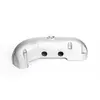Mobile:+86-311-808-126-83
Email:info@ydcastings.com
how does die casting work
Understanding Die Casting A Comprehensive Overview
Die casting is a manufacturing process that allows for the production of complex metal parts with high precision. It is widely used in various industries, including automotive, aerospace, and electronics, due to its ability to create intricate shapes and designs efficiently. This article explores how die casting works, its advantages, and its applications.
The Die Casting Process
The die casting process begins with a carefully designed mold, commonly referred to as a die. The die is typically made from high-quality steel, which can withstand the considerable pressure and temperature present during the casting process. There are two primary types of die casting hot chamber and cold chamber.
1. Hot Chamber Die Casting In this method, the casting machine features a chamber that holds molten metal, typically alloys of zinc, magnesium, or lead. The molten metal is injected into the die under high pressure through a gooseneck system. This process is continuous, allowing for rapid production rates.
2. Cold Chamber Die Casting Conversely, cold chamber casting is better suited for metals with higher melting points, such as aluminum or copper. In this process, molten metal is poured into the chamber before it is injected into the die. The cold chamber method requires more handling of the molten material but can produce high-quality parts.
Steps in the Die Casting Process
1. Preparation The manufacturing process begins with the design of the part and the creation of the die. Engineers use computer-aided design (CAD) software to ensure precision and functionality.
2. Melting the Metal The selected metal is melted in a furnace. The temperature must be carefully controlled to achieve optimal fluidity, enabling it to fill the die adequately.
3. Injection Once the metal is molten, it is injected into the die under high pressure. This pressure forces the metal to fill every cavity within the die, ensuring that even the most intricate designs are accurately replicated.
4. Cooling After the metal has been injected, it is allowed to cool and solidify. The cooling time can vary depending on the size and complexity of the part, as well as the type of metal used.
5. Ejection Once solidified, the die is opened, and the cast part is ejected. This step must be performed carefully to avoid damaging the newly formed part.
6. Finishing The final component may undergo secondary processes, such as machining, polishing, or plating, to achieve the desired surface finish and tolerances.
Advantages of Die Casting
how does die casting work

Die casting offers several benefits that make it a preferred manufacturing process
- Precision and Accuracy Die casting produces parts with tight tolerances, minimizing the need for additional machining
.- Complex Designs The ability to create intricate designs and shapes makes die casting suitable for various applications.
- High Production Rates Once the die is set, the process allows for the rapid production of large quantities of parts, reducing lead times.
- Cost-Effective While the initial cost of creating a die can be high, the efficiency and speed of the die casting process often lead to lower per-unit costs, especially in mass production.
- Material Versatility Die casting works with a variety of metals, allowing manufacturers to choose materials that best suit their production needs.
Applications of Die Casting
Die casting is used in numerous industries to produce a wide range of products. Common applications include
- Automotive Industry Die casting is widely used to manufacture components such as engine blocks, transmission cases, and housing for various automotive fixtures.
- Consumer Electronics Many electronic devices feature casings and internal parts that are die cast, providing durability and precision.
- Aerospace The aerospace industry requires high-strength, lightweight components, making die casting an ideal choice for various applications.
- Industrial Equipment From heavy machinery to household tools, die casting provides reliable and functional parts for numerous industrial products.
In conclusion, die casting is a highly effective manufacturing process that offers precision, efficiency, and versatility. Its ability to produce complex shapes rapidly makes it a valuable technique across multiple industries. As technology advances, die casting will continue to evolve, meeting the demands of modern manufacturing and innovation.
-
Why Should You Invest in Superior Pump Castings for Your Equipment?NewsJun.09,2025
-
Unlock Performance Potential with Stainless Impellers and Aluminum End CapsNewsJun.09,2025
-
Revolutionize Your Machinery with Superior Cast Iron and Aluminum ComponentsNewsJun.09,2025
-
Revolutionize Fluid Dynamics with Premium Pump ComponentsNewsJun.09,2025
-
Optimizing Industrial Systems with Essential Valve ComponentsNewsJun.09,2025
-
Elevate Grid Efficiency with High-Precision Power CastingsNewsJun.09,2025











